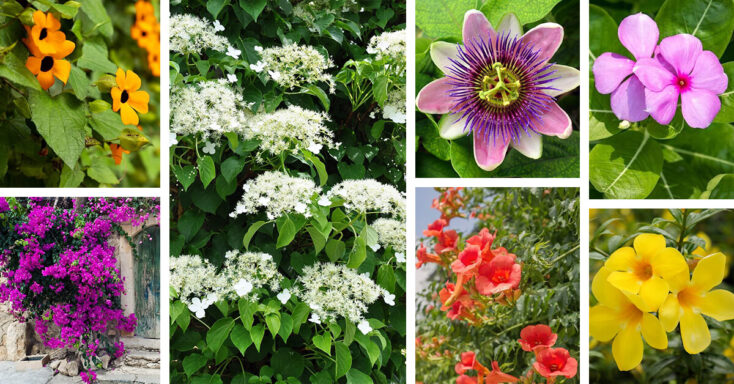Perennial flowering vines are some of the most attractive and interesting plants that you can incorporate into your planting plans. These plant species have some of the most fantastic blooms in the entire plant world. They also have an intriguing growth habit that allows them to grow on trellises, lattices, garden walls, and other structures. However, before you can select the best blooming vine for you, you must understand the options that are available to you. That’s why we’ve decided to create this article, to showcase the 24 best perennial flowering vines you can grow.
Key Takeaways
Learning about the 24 perennial flowering vines on our list below will give you plenty of knowledge about this topic. However, as you read, you should notice a few common themes that come up again and again. Here are the top five key takeaways about perennial flowering vines that you should commit to your memory:
- Flowering vines offer blooms of many different colors and shapes.
- Climbing vines often grow very quickly.
- Some perennial flowering vines are invasive species that you should avoid planting in some cases.
- Vines can climb via several different means.
- Perennial flowering vines tend to be some of the easiest to care for ornamental plants.
24 Lovely Perennial Flowering Vines that Come Back Every Year
1. Allamanda Vine (Allamanda cathartica)

The first perennial flowering vine on our list is popular throughout the Southeastern United States and is incredibly easy to care for. With just basic care and attention, your allamanda vine will spread rapidly, climbing over any structure that is nearby. As it expands, the allamanda vine develops showy trumpet-shaped flowers that have a rich yellow shade. In little time at all, this plant can reach a height of 10 feet tall and about half as wide. It also comes with several different cultivars, which offer you different unique variations of the same lovely climbing plant.
2. American Bittersweet (Celastrus scandens)
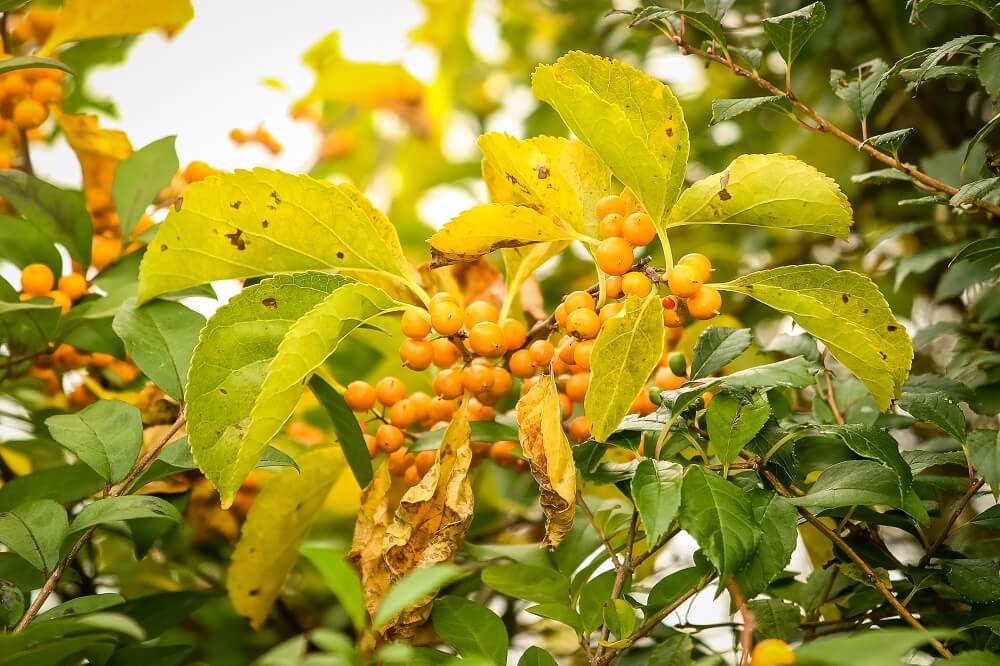
If you are an American, then you have likely heard of the oriental bittersweet. This non-native vine species is one of the most pervasive invasive plants in the entire country. However, did you know that there is a native version of this plant that is entirely benign? The American bittersweet has some characteristics similar to the oriental bittersweet, but it does not cause the same kind of damage to the environment. Perhaps the most noteworthy of those characteristics of the American bittersweet is this plant’s fruits, which look like many colorful miniature ornaments that hang below the leaves.
3. Bougainvillea (Bougainvillea)
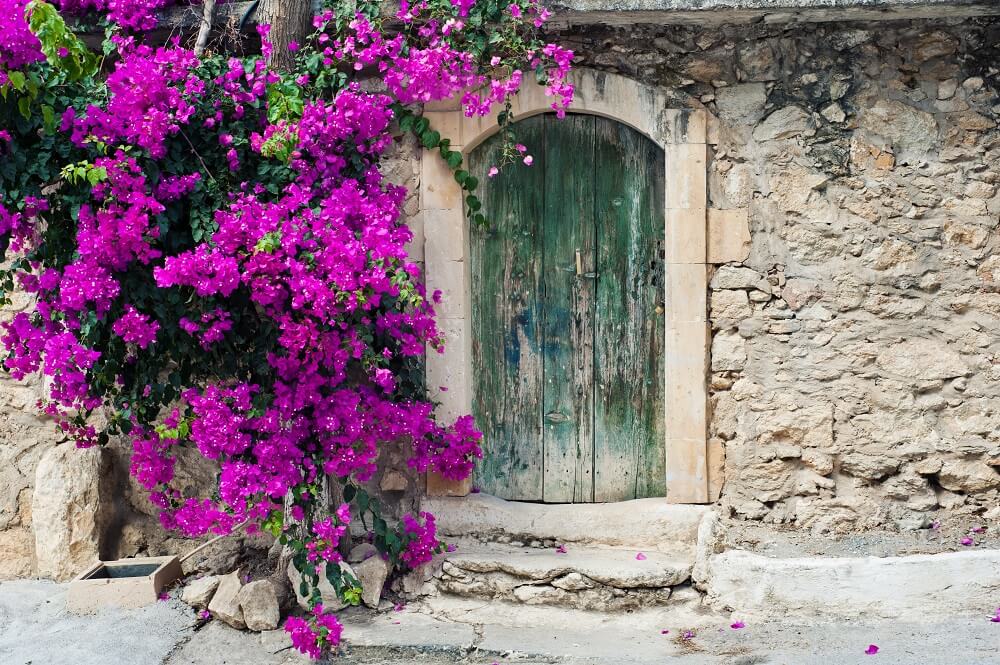
The bougainvillea is not only one of the most impressive flowering vines, but it is also one of the most impressive flowering plants overall. This plant has a fantastic climbing growth habit that adapts perfectly to garden walls. It also blooms with more vibrant purple flowers than you can imagine. Those flowers are striking thanks to their vibrance, and they are also long-lasting as well. So if you want a flowering vine that will add a pop of color that you cannot miss, then the bougainvillea is the right plant for you.
4. Black-Eyed Susan Vine (Thunbergia alata)

The common name of this plant will likely lead you to believe that this species is at least a close relative of the other black-eyed Susan plant that goes by the botanical name Rudbeckia hirta. However, the truth is that the black-eyed Susan vine is hardly related to that species at all. Despite that, these plants have some similarities. For example, they both are perennials with distinct flowers. Those blooms consist of yellow petals that surround a dark, nearly black center. What makes the black-eyed Susan vine so different, as you might guess, is that it is a climbing plant.
5. Bleeding Heart Vine (Clerodendrum thomsoniae)
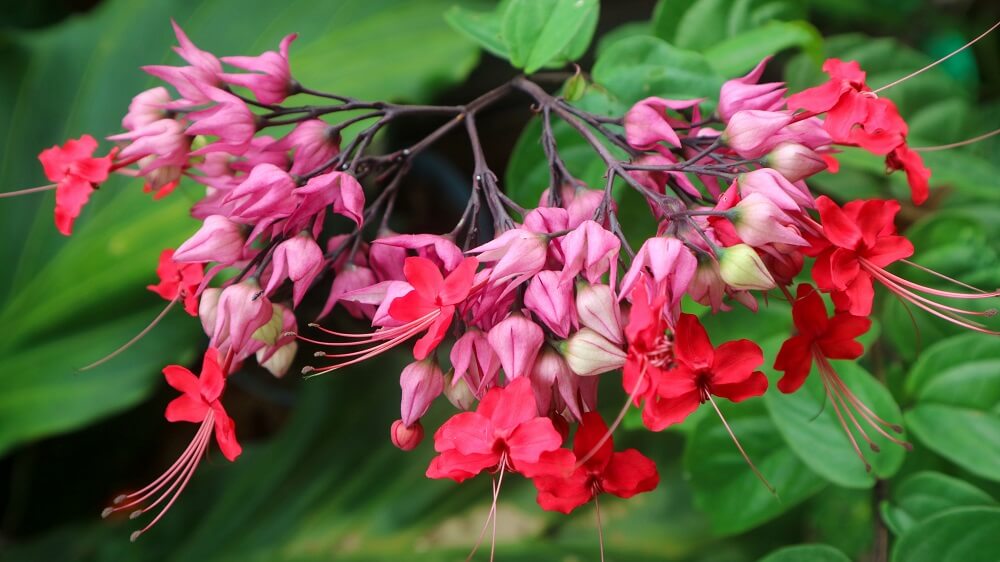
Here’s another plant that shares a name with another popular ornamental perennial plant but does not share a close genetic relationship. Nevertheless, the bleeding heart vine is one of the most beautiful flowering perennial vines you can grow. Each individual flower offers sharp color contrast all on its own. In many cases, the flowers of the bleeding heart vine will be primarily white, with dark red accents. However, this plant’s blooms can have different colors depending on the variety you get. You’ll also enjoy that this plant is easy to care for and has minimal issues related to pests and diseases.
6. Cape Honeysuckle (Tecoma capensis)
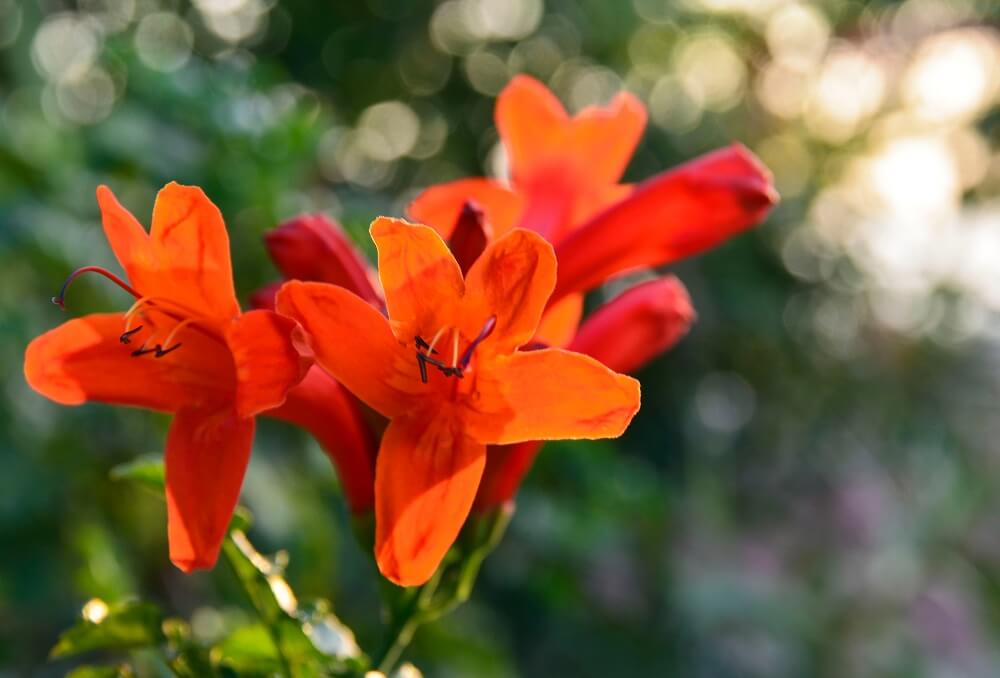
The cape honeysuckle plant has orange flowers that you are sure to love. Those flowers are vibrant with relatively long petals and long, spindly, central reproductive structures. However, the flowers are far from the only interesting fact about this plant. One of the most captivating features of the cape honeysuckle is that it can grow as a shrub or as a climbing vine. If you are interested in the latter of those growth habit options, then make sure that you grow your cape honeysuckle near a structure it can climb. It may also help to train your plant to climb from a young age.
7. Cardinal Climber (Ipomoea quamoclit)
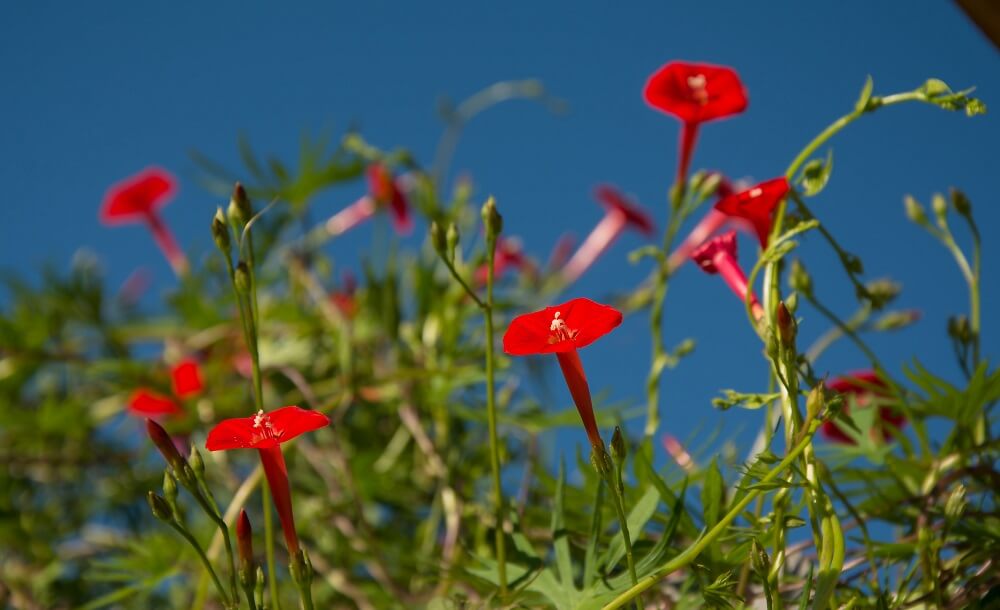
The amazing flower of the cardinal climber stands out for multiple reasons. First, they have a nearly perfect red color that will stand out in comparison to every other plant in your garden. Those flowers also have an upright growth habit that makes them even easier to notice. Additionally, the shape of those flowers is captivating as well. Each flower has a saucer-like portion that sits atop a long tubular center. That combination of flower characteristics makes the cardinal climber a unique species among the perennial flowering vine plant family.
8. Chocolate Vine (Akebia quinata)
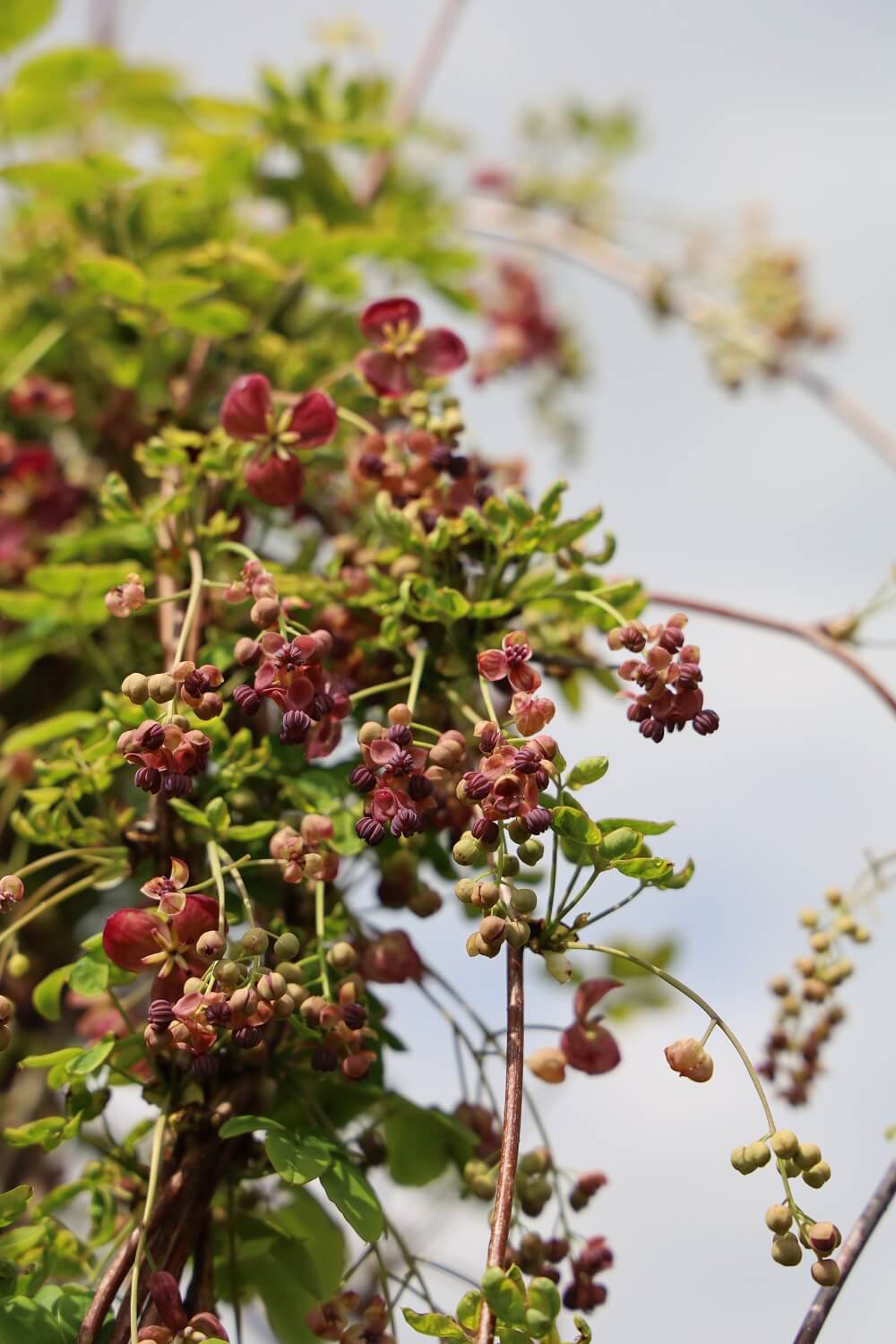
Most flowers give off an alluring scent when they are in bloom. However, few plants have an aroma that is like that of the chocolate vine. In keeping with this plant’s common name, the flowers of the chocolate vine have a smell that is a lot like that of chocolate. The appearance of these flowers is somewhat chocolaty too. They have a deep purple hue that is almost like a chocolate brown shade. Chocolate vines are also quite adaptable, especially when it comes to sun exposure, as they can grow in both full sunlight and areas that are almost fully shaded.
9. Clematis (Clematis)
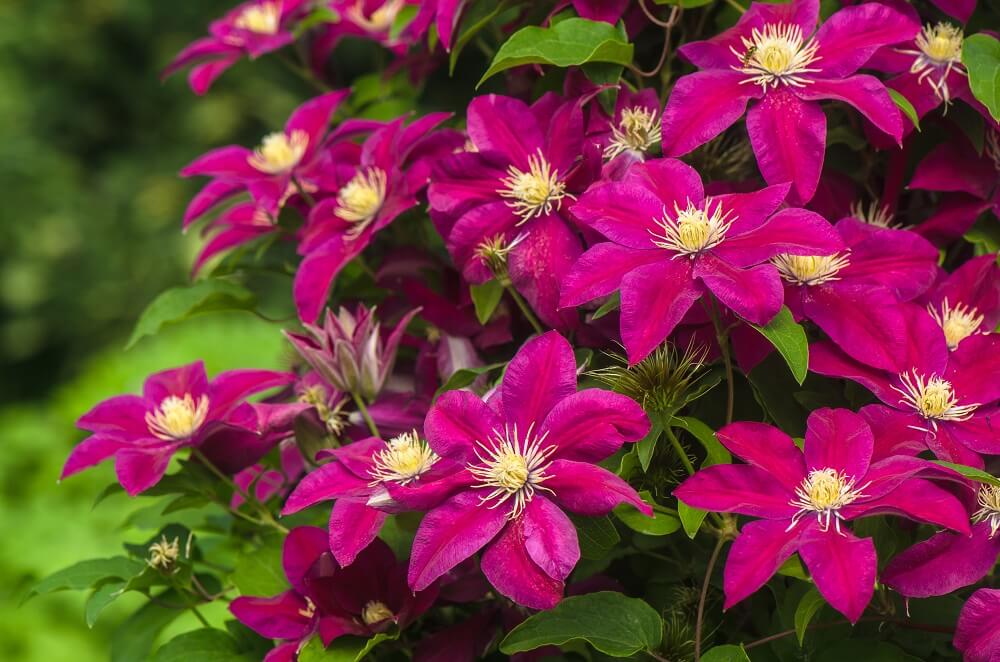
The clematis vine, sometimes called the leather flower, is a perennial vine with flowers that are essentially perfect. They have six broad petals that can vary in shade from white to purple and blue and may even show two tones at once. These petals are so large that each flower measures several inches in diameter. Since those flowers appear in relatively high volumes at times, a clematis plant can quickly become the most noticeable focal point in your garden. Additionally, these vines often look their best when they wrap their elegant stems through a trellis that is equally ornamental.
10. Climbing Hydrangea (Hydrangea anomala subsp. petiolaris)
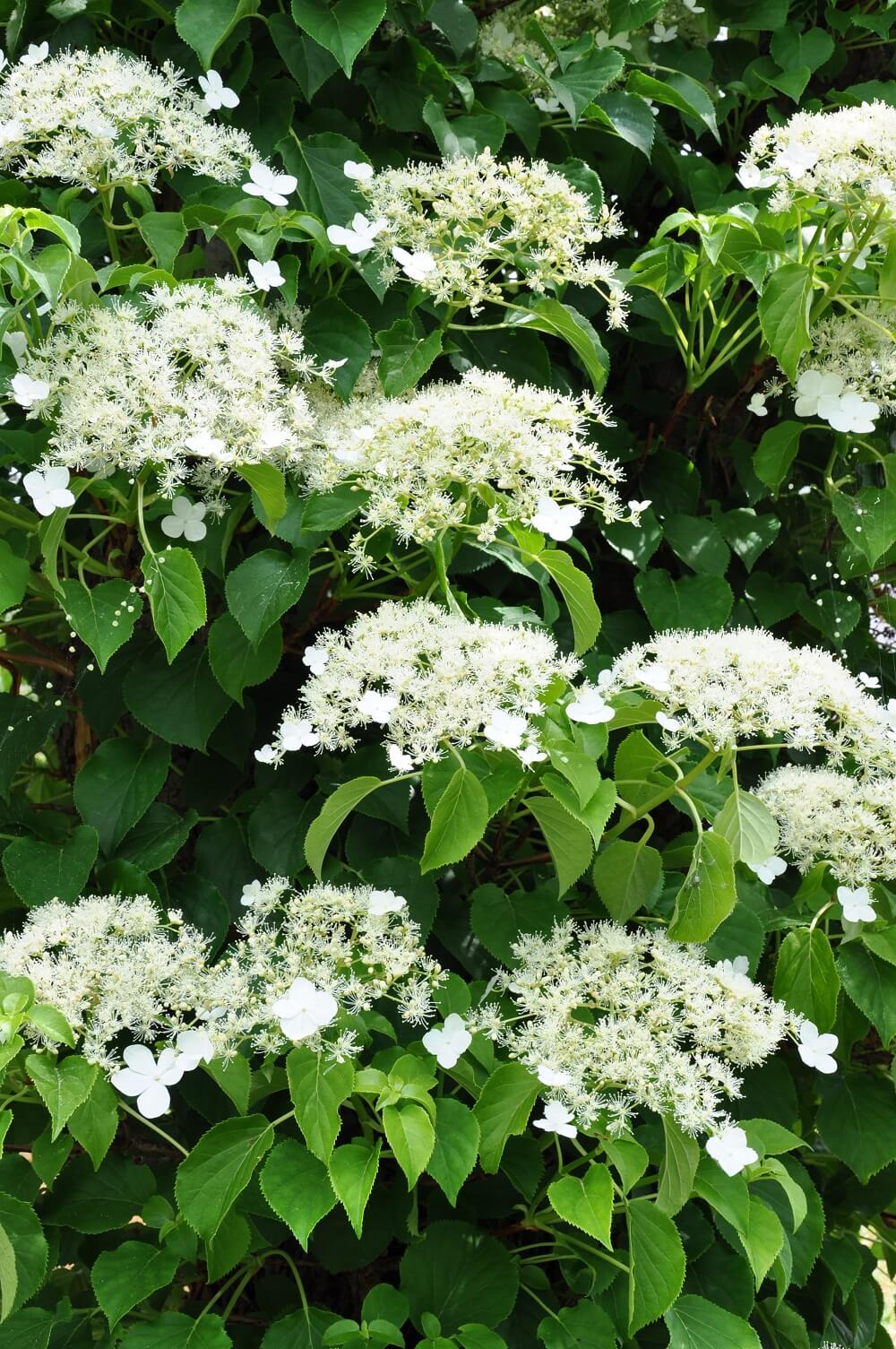
If you know about the shrub version of a hydrangea, then it is no surprise to learn that the climbing hydrangea variety has blooms that are just as gorgeous. At the same time, there is another perennial climbing vine that claims the climbing hydrangea name, this subspecies, Hydrangea anomala subsp. Petiolaris, is a true climbing hydrangea as it belongs to the Hydrangea genus. When in good health, climbing hydrangeas are substantial plants that can add a lot of mass to your planting schemes. Depending on the type you get, you may also find flower clusters of pink rather than the typical white.
11. Cup and Saucer Vine (Cobaea scandens)
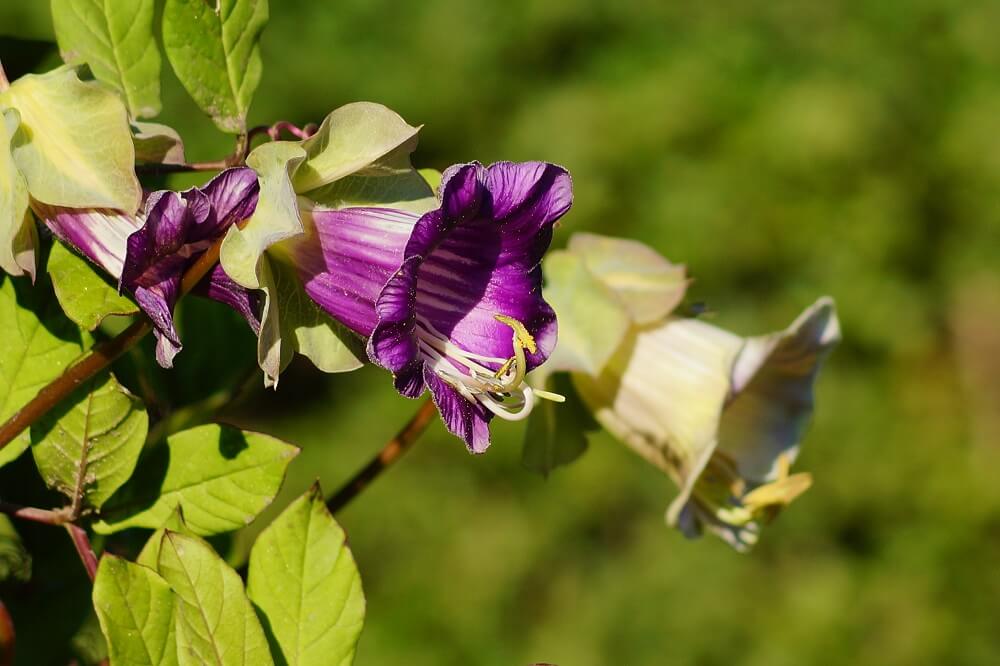
The cup and saucer vine is a climbing plant that looks like it is hosting a tea party for most of the spring and summer months. That look is all thanks to the shape of this plant’s showy flowers. The blooms of the cup and saucer vine have petals that form a cup shape with a frilly edge, while the leaves at the base of the flower form a similarly frilly saucer shape. Like many of the other perennial flowering vines on our list, this one has a fast growth rate and a large overall size that can exceed 30 feet.
12. Honeysuckle (Lonicera japonica)
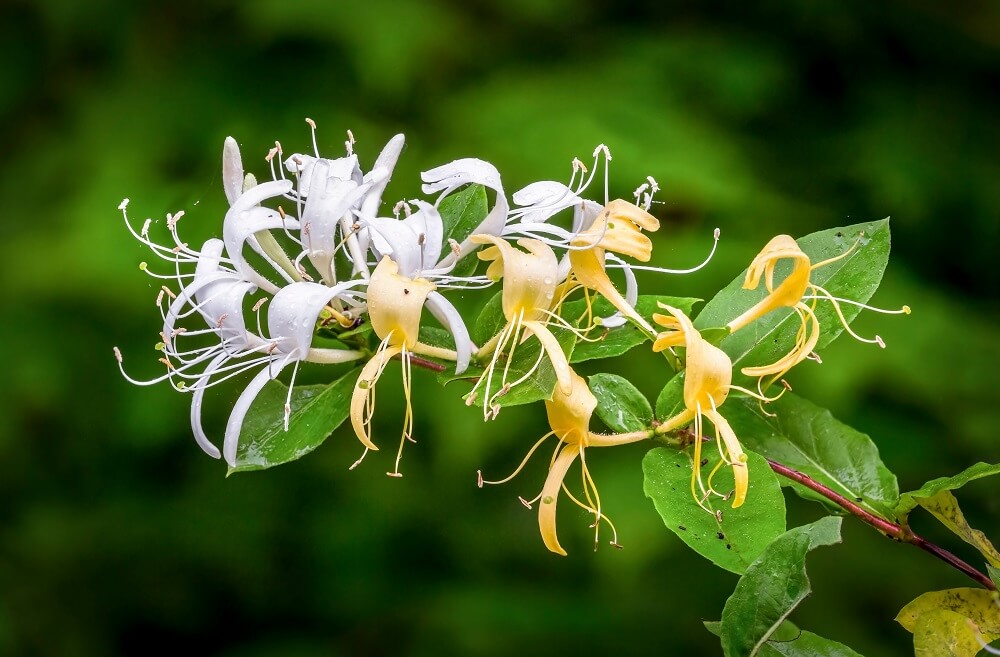
The honeysuckle vine comes from East Asia originally, which is why it sometimes has the name Japanese honeysuckle. In nature, it is common for the honeysuckle vine to attach itself to tall forest trees and climb to heights of 40 feet or more. In garden use, it is tempting to plant honeysuckle as a climbing vine of choice due to its flowers, which are both brightly colored and fragrant. However, since this plant is highly invasive in some regions, you should do your research before planting it. Even if honeysuckle is not invasive in your area, you may still find yourself having difficulty controlling its spread.
13. Madagascar Periwinkle (Annual vinca)
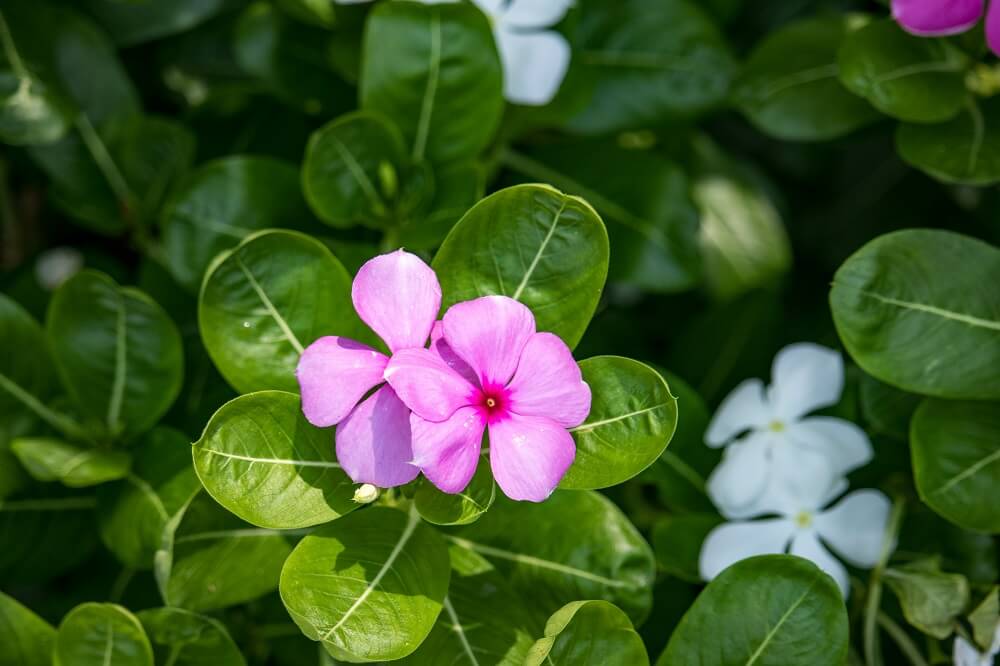
The flowers of the Madagascar periwinkle vine are nothing short of delightful. These adorable blooms have five petals that surround a colorful center and create a pinwheel-like shape. At times, those petals will be a simple white color. In other instances, the petals will be pink with magenta centers or entirely purple. But no matter what color the flowers are, they will set themselves against lush foliage that consists of many glossy oval-shaped leaves. Overall, the interaction of flowers and foliage that a Madagascar periwinkle provides makes for the ideal color palette for many gardens.
14. Morning Glory (Ipomoea purpurea)
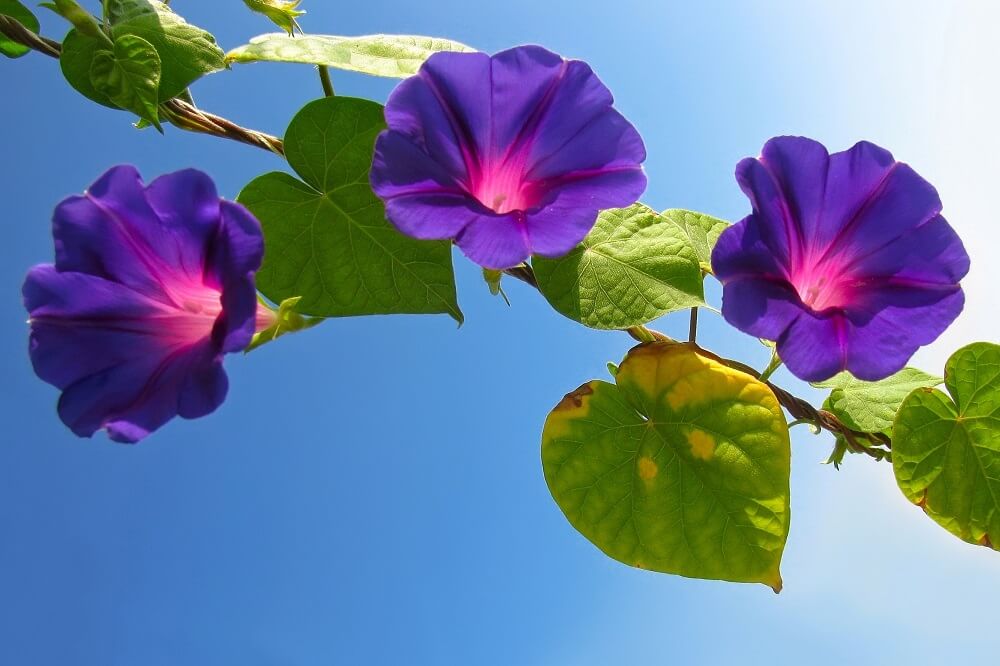
The morning glory plant is not the only species within the Ipomoea genus that we will mention on this list of the best perennial flowering vines, but it is perhaps the most recognizable for its blooms. The common morning glory vine has trumpet-shaped tubular flowers that face upward toward the sky. Those blooms are usually a light lavender color at the top that gradually fades to pure white at the base of the flower’s tube. That flower base attaches to a graceful and slender vine that can widen its way impressively through many different types of garden structures. In fact, the soft and subtle nature of the morning glory plant often perfectly juxtaposes the comparatively rigid strength of many garden constructions.
15. Passion Flower (Passiflora incarnata)

If planting a passion flower vine is your goal, you should begin by understanding that the term passion flower can apply to plants of several varieties. Some of those varieties are perennial flowering vines, and some are not. Likewise, many of the passion flower plants, whether they grow as vines or not, will produce edible fruit. Still, as shown by the fact that few people plant this species for the sake of collecting a harvest, the most prominent reason you’ll be passionate about the passion flower is the characteristics of the flowers themselves. Those blooms are quite large, with strange and prominent central reproductive structures and strikingly colorful petals.
16. Perennial Sweet Pea (Lathyrus latifolius)

The perennial sweet pea is an herbaceous plant that is as attractive as it is fast-growing. In a single growing season, you can expect to witness this climber reaching heights of 10 feet or more when growing conditions are right. During that time, the perennial sweet pea will bloom with pink flowers that are almost orchid-like in their shape. This plant is also a good supporter of wildlife as its flowers provide nectar to several pollinators. But despite attracting some forms of wildlife, the perennial sweet pea also tends to be resistant to deer browsing, which makes it all the easier to care for and keep alive throughout its active growth season.
17. Rocktrumpet (Mandevilla)
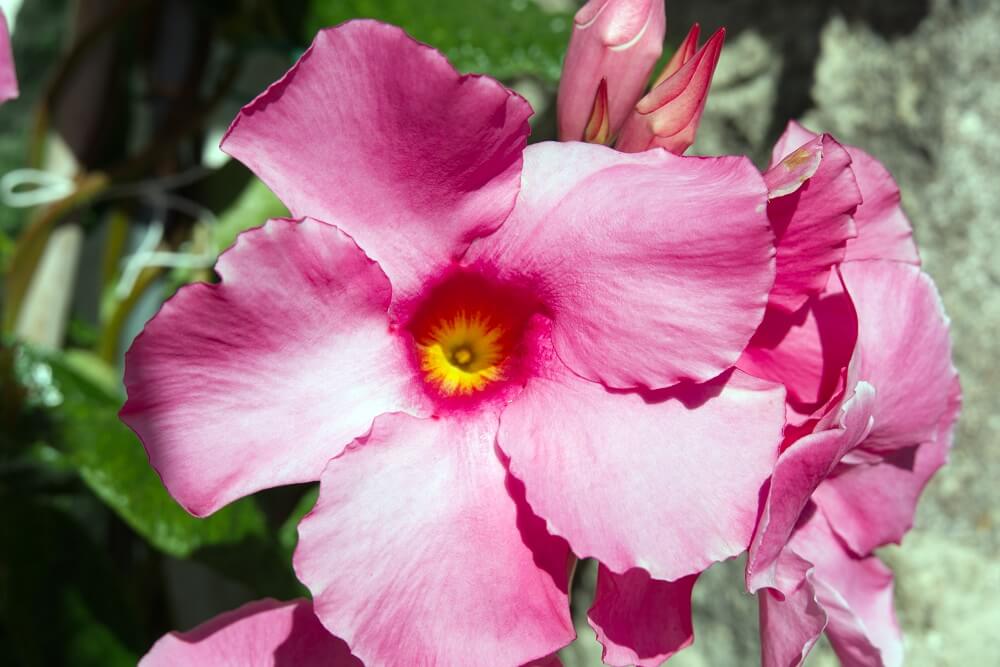
The name rocktrumpet , or Mandevilla, is a name we use to refer to several flowering plant species that grow as perennial vines. Within this genus, different species provide different flower colors and characteristics, along with subtle differences in size and overall growth habits. But with that said, each of those many varieties tends to be between 8 and 15 feet tall at maturity. Likewise, most, if not all, of the popular rocktrumpet varieties are native to South America, meaning that they typically prefer warm growing conditions. Along with those similarities, rocktrumpet plants also share an ability to produce fantastic flowers of varying colors.
18. Snail Vine (Cochliasanthus caracalla)
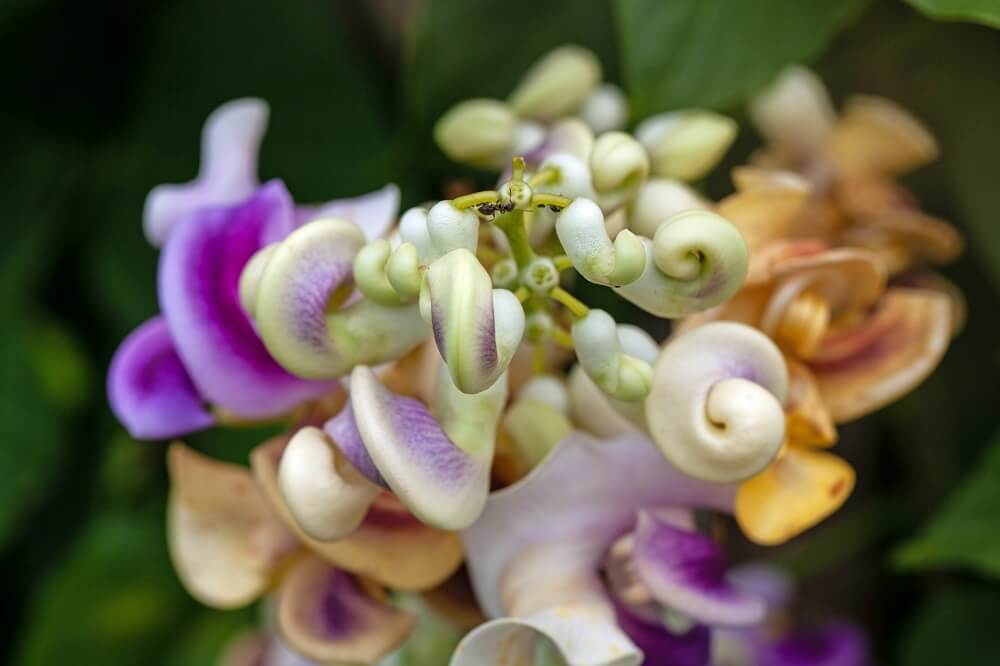
Don’t let the snail vine fool you. Despite the common name we use for this perennial flowering vine, it is anything but a slow grower. On the contrary, this plant easily reaches 10 feet tall in a single summer. As is true of other plants on this list, the snail vine has some incredible flowers and foliage, but you’ll need to provide the right light exposure to witness them to their fullest. In the hotter parts of this plant’s growing range, too much direct sunlight can lead to its demise. However, with the right amount of sunlight, the snail plant will shite as well, with knobby flowers that have an almost snail-like form at times.
19. Snapdragon Vine (Maurandya scandens)
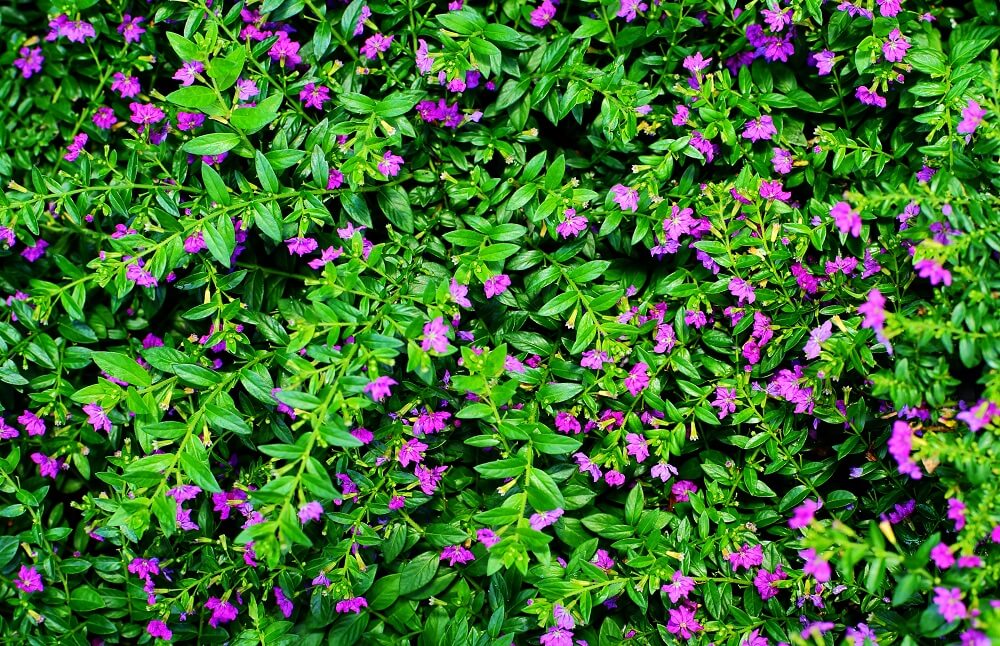
The snapdragon vine will make for a fantastic climbing plant or ground cover, even if you give it minimal care. This species requires minimal watering to maintain its vigor and produce some long-lasting blooms as well. Typically, these blooms have a pink or purple color and can appear scattered throughout the shiny green foliage. This plant grows by twining its vines through its supporting structure, which makes it the perfect flowering perennial vine for trellises, arbors, and any garden structure that has gaps through which the snapdragon vine intertwines itself. However, even if you don’t have a support structure for this plant, it can still make for a beautiful ornamental ground cover.
20. Star Jasmine (Trachelospermum jasminoides)
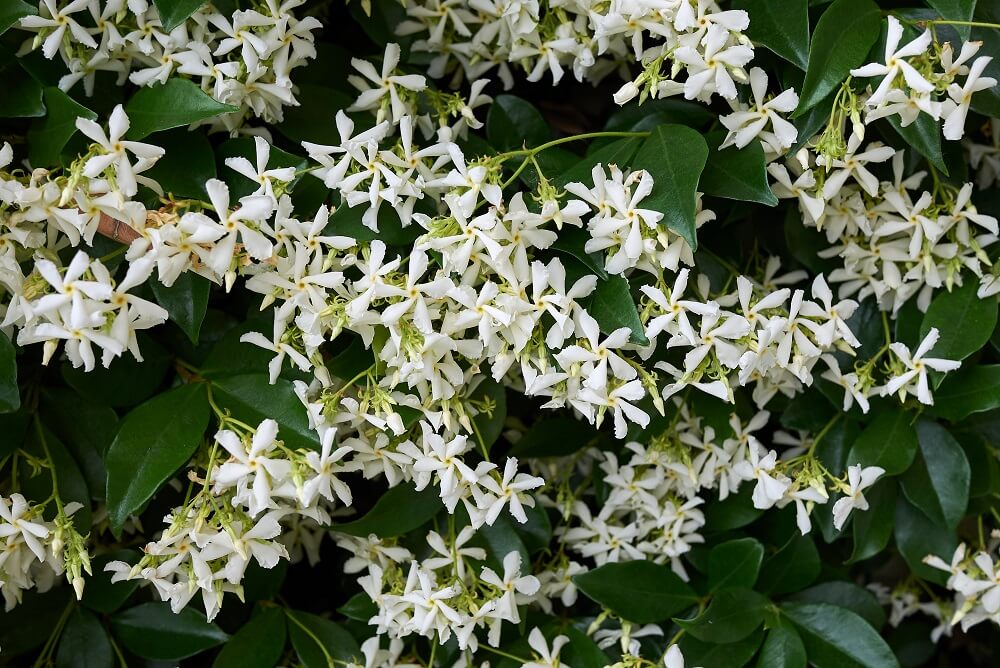
Star jasmine gets its name and much of its notoriety within the garden community thanks to its blooms, which are small, star-shaped, and appear in large quantities during the bloom time. Thanks to that high volume of blooms, the star jasmine plant is also able to give off a fragrance that will please all of your garden guests upon their arrival at your property. The foliage that this plant produces is also quite numerous, so much so that it makes for a consistently dense mass of green that may come to engulf the structure on which your star jasmine grows.
21. Sweet Autumn Clematis (Clematis terniflora)
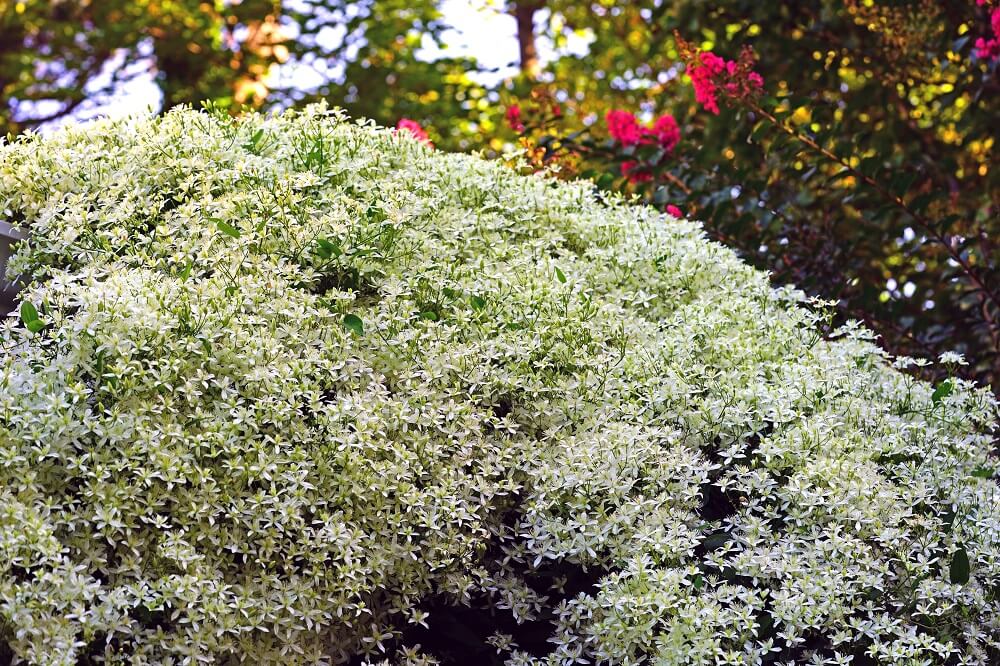
The sweet autumn clematis is the perfect follow-up to the previous plant on our list. Both this entry and the star jasmine before this have small white flowers that have a slender star shape. Both are also quite fragrant, which is, in fact, the source of the sweet autumn clematis name. Overall, the sweet autumn clematis requires an average care routine if you want this plant to look its best. This species is also another option for those who want to create a dense ornamental flowering ground cover as well. All you need to do to achieve that look is prevent your sweet autumn clematis from climbing any nearby structures or plants.
22. Sweet Potato Vine (Ipomoea batatas)
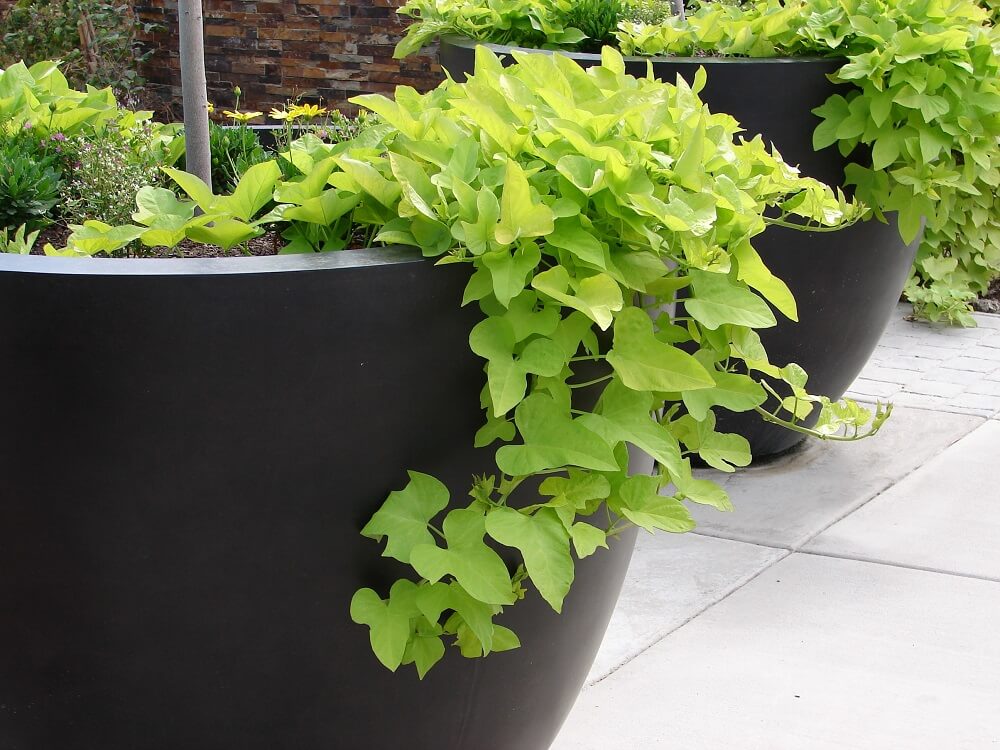
The sweet potato vine is not a plant that you should expect to harvest sweet potatoes from. Instead, it is a purely ornamental species that has some amazing visual characteristics. However, although this plant appears on our list of perennial flowering vines, it is better known for its foliage rather than its blooms. Those leaves can be either deep purple or a light lime green shade and have a shape that is equally interesting to the eye. In fact, it is rare for the ornamental sweet potato vine to bloom at all. But in the cases in which it does, its purple tubular flowers are sure to impress anyone who catches a rare glimpse of them.
23. Trumpet Creeper (Campsis radicans)
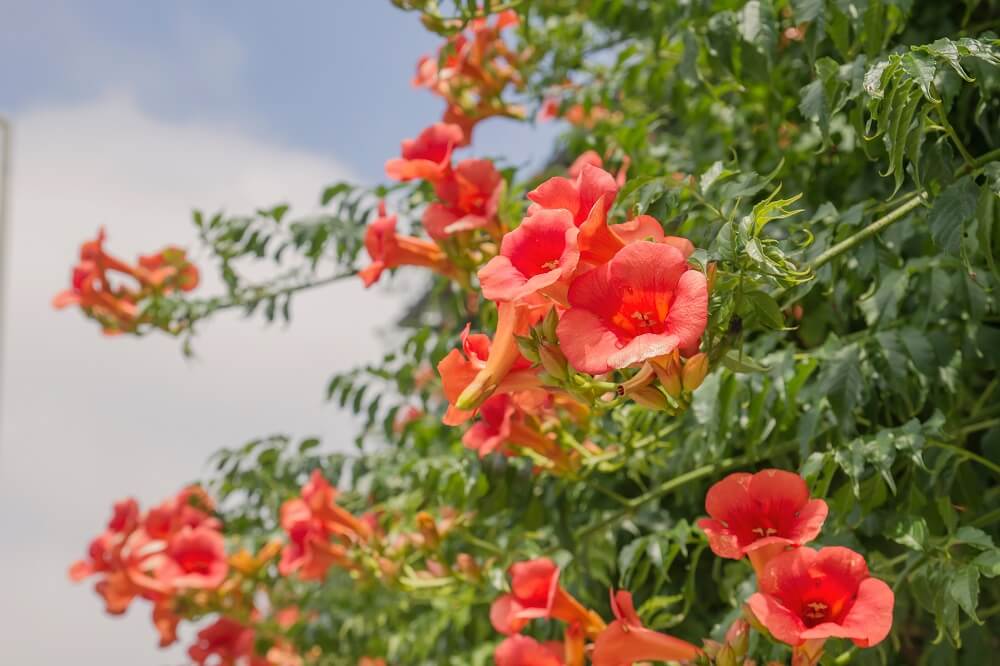
The trumpet creeper announces itself, as well as any other flowering plant that you can imagine. The fact that this plant is also an excellent climber is just an added bonus. For much of the hotter parts of the growing season, this sprawling vine will cover itself with orange, trumpet-shaped flowers that are as attractive to the humans who enjoy their beauty as they are to pollinators that seek to feed on the nectar of this plant and conduct pollination in the process. In many ways, the trumpet creeper is the perfect plant to grow over a solid fence or a garden wall, as it will spill itself gracefully over the top of the wall when it reaches maturity, creating an astonishing cascade of orange.
24. Wisteria (Wisteria sinensis)
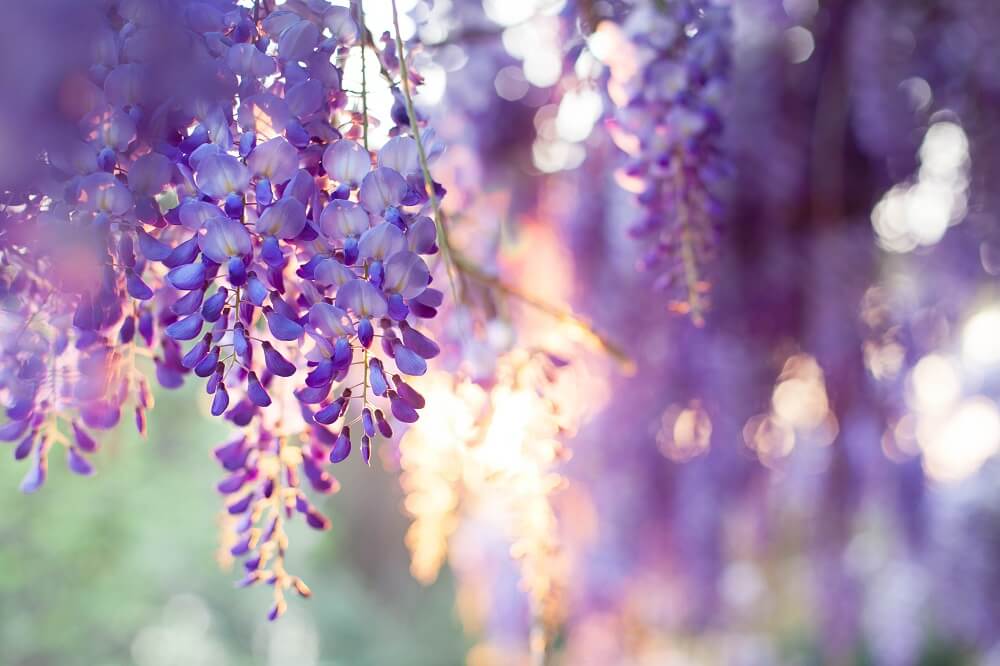
Wisteria sinensis, otherwise known as Chinese wisteria or simply wisteria, is a plant that you should grow with great caution. While this plant is incredibly beautiful, it is also aggressive and even invasive in many instances. But even if this plant is not invasive in your area, you will need to tend to it with regular pruning so that it does not dominate the other plants in your garden as it spreads. Still, if you are able to keep this plant in check and it is not invasive in your area, it will reward you greatly. Wisteria plants have an almost indescribable bloom time that involves countless large dangling panicles of light shimmering purple flowers. For some, that effect alone is enough to put up with some intensive maintenance.
Frequently Asked Questions About Perennial Flowering Vines
What is the Easiest Flowering Vine to Grow?
Although perennial flowering vines come from many different genera, many of these plants prove to be very easy to care for, so much so that it is almost impossible to select a single species that is the easiest to care for. When they have access to the growing conditions they prefer, perennial flowering vines will not only look great but climb quickly as well, which means they are vigorous and easy to keep alive. Within this plant group, clematis vines, trumpet vines, and black-eyed Susan vines are some of the easiest to care for, but there are plenty of low-maintenance flowering vine options.
Which Vines Flower is the Longest?
There are a few perennial flowering vines that have blooms that are beautiful but, unfortunately, somewhat short-lived. However, there are also plenty of plants in this group that offer incredibly long-lasting blooms. For instance, the Bougainvillea vine has flowers that are not only copious but remain on the plant for quite some time. The same can be said of honeysuckle vines and many others.
What is the Meaning of Perennial Vine?
To understand the meaning of the term perennial vine, let's break it down one word at a time. The word perennial implies that a plant will return year after year, as opposed to annual, which lasts for a single growing season. The term vine is a general term that refers to climbing plants. Thus, perennial vines are plants that return year after year and have a climbing growth habit. That broad definition allows many plant species to fall into this category.
Are Climbers Perennial?
There are plenty of climbing plants that are perennials, as our list above thoroughly proves. However, there are also climbing plants that can grow as annuals. As is true of any plant group, which flowering vines grow annually depends on where you live. For example, plants that come from regions hotter than your own are more likely to grow as annuals in your area that need to be replaced each year after the winter ends.
Is Clematis a Perennial?
Clematis vines are perennial flowering vines that will return every year. During the early spring, they will begin to develop and eventually produce large flowers that bloom in late spring to early summer. Once the summer and fall come to a close, a clematis vine will begin to die back. At this stage, you cut the plant back almost to the ground. Once spring arrives once again, you can expect your clematis to begin producing new growth as well.
Growing perennial flowering vines is an exciting and engaging gardening topic that prompts many plant enthusiasts to have several common questions about these climbing ornamental plants. Below are a few answers to the most popular ones.
24 Assorted Perennial Flowering Vines that Offer Something for Everyone
The good news about perennial flowering vines is that these plants are very easy to care for and will grow quickly. That means that once you select the species that is right for your garden, you won’t need to wait very long before you can start seeing the results you want. While there are other perennial flowering vines in existence, the ones that we listed here are some of the most common and popular options that you should be aware of, so feel free to return to this list whenever you want to grow a lovely ornamental vine that will enhance the appeal of your property every year.


